The unmistakable influence of the climate crisis helped cause New York City to be inundated by a month’s worth of rain within just a few hours on Friday, scientists have warned, amid concerns over how well the city is prepared for severe climate shocks.
A new rapid attribution study, released by scientists in Europe, has found that the type of storm seen on Friday is now 10-20% wetter than it would have been in the previous century, because of climate change.
Flash flooding soaked large parts of the US’s largest city, turning roads into rivers, following intense rainfall that broke records. John F Kennedy international airport measured 8in of rainfall in one day, the most since records began, while Brooklyn received a month’s worth of rain in just a few hours. People had to be rescued from swamped basement apartments, subway and bus services were canceled and sewage backed up in overwhelmed pipes.
Climate scientists have stressed that such pounding rainfall is a symptom of a warming planet, with a hotter atmosphere able to hold more moisture that is then unleashed in torrential downpours.
“Human-driven climate change plays a dual role, both intensifying these storms and warming the atmosphere,” said Davide Faranda, a scientist at the Institut Pierre-Simon Laplace in France. “Deeper storms yield more intense phenomena, while a warmer atmosphere can accommodate a greater amount of rain.”
Tommaso Alberti, a researcher at Italy’s Istituto Nazionale di Geofisica e Vulcanologia, said that the extreme event that hit New York “aligns with climate change projections”. He added that while natural variability can deliver major storms, “human-driven climate change is the primary driver, underscoring the urgent need for climate mitigation and adaptation efforts”.
Global heating has fueled contrasting extremes in rainfall across the US. While much of the arid south-west has faced prolonged drought – punctuated by occasional disastrous flooding events – the US north-east, including New York, has seen a significant increase in heavy rainfall. The amount of precipitation falling in heavy events in the region has increased 55% since the 1950s, a federal government analysis has found, with climate change the main cause of this.
Michael Mann, a climate scientist at the University of Pennsylvania and author of a new book on the climate crisis, said that rapid attribution studies can miss some of the mechanisms that cause extreme weather, but that the increased threat of flooding was nevertheless undeniable.
“New York is experiencing a very clear increase in these extreme – more than 2in per hour – rainfall events, and that’s clearly tied to a warming atmosphere,” he said.
Such flooding can be deadly. In 2021, New York was hit by Hurricane Ida, which caused 11 people to die from flooding that seeped into the basement apartments where many New Yorkers live.
Following scenes where parts of New York again resembled a giant, fetid swimming pool, and less than four months after the city’s skies turned a toxic orange from wildfire smoke, questions have been raised about the preparedness of the metropolis, along with many other major cities, to escalating climate impacts.
“The sad reality is our climate is changing faster than our infrastructure can respond,” Rohit Aggarwala, commissioner of the New York City department of environmental protection, admitted on Friday. Pipes and drains could not cope with the flood water, while the leadership of the city and state – including the city’s mayor, Eric Adams, and the governor, Kathy Hochul – has come under criticism for responding too slowly to the looming threat posed by the rainfall.
“It’s clear that our cities and our aging infrastructure were built for a climate that no longer exists, particularly as a warmed atmosphere holds and releases more water,” said Daniel Zarrilli, the former chief climate policy adviser to New York City.
“This requires not only greater investment to deal with the new extremes, but also the creativity to think differently about design for when the capacity of our infrastructure is inevitably exceeded.”
